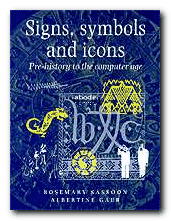history and development of iconography
As its title suggests, this study of iconography uses a structure of historical progression to argue that symbolic presentation has been “part of the collective subconscious of the human race since earliest times”. In the first part of the book Albertine Gaur compresses a great deal of cultural history and draws on an impressively wide range of ethnographic reference to argue the case. She starts with non-verbal scripts used as mnemonics, tallies, maps, and marks of ownership – many of which are still with us in the form of title brands, logos, watermarks, and seals. Then she deals with fascinating examples of number symbols, iconography in religion and art, and even the [possible] origins of phonetic writing.
 At its weakest this is not much more than a very elegantly illustrated list, with examples jumping from pre-Christian culture on one page to New York subway graffiti on the next. At its best, it is an example of a writer who can make her scholarship attractive, accessible, and inviting to her audience. Reading this filled me with a curiosity to look at her other work.
At its weakest this is not much more than a very elegantly illustrated list, with examples jumping from pre-Christian culture on one page to New York subway graffiti on the next. At its best, it is an example of a writer who can make her scholarship attractive, accessible, and inviting to her audience. Reading this filled me with a curiosity to look at her other work.
In the second part of the book Rosemary Sassoon teases out the layers of meaning behind the apparently simple term ‘icon’ – showing that it can stretch from a universal element [fire] to include words and even whole literary works:
we write letters but we read words. Words therefore become hieroglyphs or icons themselves. As an extension, in some cases and for some people, sentences, poems or whole works of literature (Shakespeare, for instance) or religious belief (the Koran) become icons in themselves.
The writing is full of wonderfully suggestive language – ‘cartouche’, ‘glyph’, ‘ideogram’, ‘pictographic’, ‘boustrophedon’ – and the subject is presented in a thought-provoking manner. But we are taken from one aspect of the subject to another without any firm sense of structure or reasoned exposition. For instance, we are dropped into an encomium of aboriginal iconography on one page with a claim that ‘no future iconography is likely to approach that level’ – only to then be rushed on to dingbats with no connecting argument.
This sense of fragmentation is exacerbated by the fact that the second part of the book in fact has several authors (who are only credited in the small print of ‘acknowledgements’ and marginal notes). There are two chapters on iconography and its relation to what are now called [in PC-speak] ‘special needs’. ‘Symbol systems for the visually impaired’ includes some fascinating material on alternatives to Braille, and ‘A new iconography for deaf signers’ discusses some socio-linguistic aspects of what can sometimes be quite a controversial topic.
A chapter on musical notation is not much more than a description of traditional craft methods, followed by an acknowledgement that what was once a laborious process can now be done easily using computers. It’s not until we reach Adrian Grater’s chapter on movement notation that we get closer to the IT element promised in the title. He describes in some detail the cognitive process of constructing a software program which can record the subtleties of dance in graphic form.
Sassoon comes in again at the end with an attempt to pull all the threads together – but by then it’s too late. The strength of this book is that it is packed with disparate and thought-provoking items – but that’s also its weakness. The illustrations are plentiful and excellent, and it’s obvious that the authors [editors?] have a strong purchase on an interesting subject. Maybe they would do it more justice to it if they narrowed the focus of their approach and spent longer explaining the case they wish to make.
© Roy Johnson 2002
Rosemary Sassoon and Albertine Gaur, Signs, Symbols and Icons: Pre-history to the computer age, Oxford: Intellect, 1997, pp.191, ISBN 1871516730
More on writing skills
More on theory
More on typography